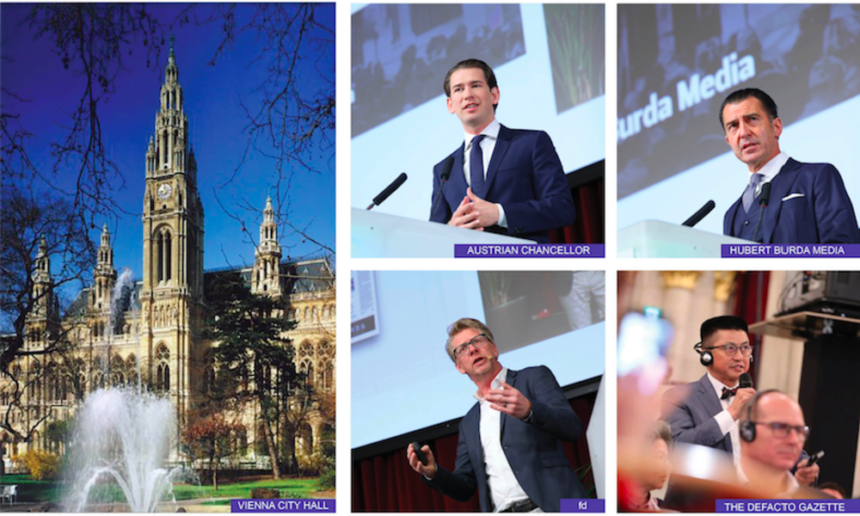“In Europe today, journalism is at risk and media is in danger” said Philipp Welte, a board member of Germany’s largest media holding company Hubert Burda Media, at the European Publishing Congress held last week in a historical city hall building in Vienna, Austria’s capital city. Hubert Burda Media is a large media corporation that has an annual revenue of 2 billion USD, employs 10,000 people, and publishes a number of popular magazines (Focus, Bunte, Chip, Playboy), each of which has more than half a million subscribers. So, if someone from their boardroom says the media is in danger, the threat can be considered as real.
Starting from this year they changed the name of the congress from ‘European Newspaper Congress’ to ‘European Publishing Congress’, so that it reflects the involvement and participation of online magazines and publications. This time the 20th annual congress saw an attendance of over 500 media executives, editors, journalists, and public servants from 35 countries. What happens in the world today cannot be fathomed without its digital dimension, which includes social networks such as Facebook and Twitter. Same goes for media, not only in Europe, but also globally.
Having attended the congress representing Mongolia and exchanging feedback and experience on key issues faced by the press today, I’ve summed up my reflections below.
Danger faced by democracy
Everywhere in the world, traditional media are facing threats and increasingly struggling to operate as normal. Their revenue is plummeting, which means they are having bigger challenges to pay for their journalists, reporters, photographers, videographers, and editors. Journalists connect thousands of dots between people and the public officials that are elected by them. But now both journalism and journalists are at risk.
On one hand, the far-right political parties and politicians have made the job of reporters one of the riskiest professions. Telling the truth is costing lives. Turkey has fired 130,000 public servants, put 160 reporters in jail, and closed down 190 media publishers. In 2018, a total of 182 reporters were killed globally, while the casualty this year stands at 12 as of April. A total of 328 reporters are currently imprisoned across the world.
On the other hand, social network is full of fake news, and people can’t tell fact from fiction. False accusations, slander, defamation, and toxic political agendas are being carried out at a professional level. Fake news have spread throughout the world. At the same time, large social network corporations such as Facebook and Google are seeing greater revenue from ads, whereas the traditional media keep getting reduced income. In 2018, Germany’s 2,000 magazines made a combined ad revenue of 980 million EUR. In contrast, Facebook alone earned 1.28 billion EUR, and Google made even more.
The United States was the first nation ever to include the freedom to speech in their constitution. However, the U.S. president is now labelling reporters and journalists as ‘fake people’. As the opportunity to tell the truth becomes more limited, democracy is facing greater threats. While accountable reporting gradually disappears, it is giving a rise to fake news and reporting without verified, accountable sources. Social networks continue pushing traditional media out of the scene. It is said that, in 2033, Germany will produce their last newspaper to be printed on paper.
The European press are saying that we need to fight to get our freedom back, because the most fundamental democratic values – including those that allow us to voice our opinion, freely elect our representatives, and be able to provide oversight – are disappearing.
There is an emerging need to educate people on distinguishing between fact-based reporting and fake news, and to enable professional journalists and reporters to rise above the social network with their content and accountable reporting.
Traditional media’s digital transition
There is an interesting example in the oldest Dutch newspaper (fd) and how they were able to reinvent themselves and adapted to new circumstances successfully. This newspaper, which was first published in 1796, transitioned to Berliner format in 2011, incorporating six columns. This transition also involved publishing and distributing their newspaper in digital format. As a result, the number of their subscribers rose from 52,000 in 2006 to 92,000 today. Their chief layoutter Hans Spoelman said that they are distributing the newspapers to every dimensions, including digital, and their journalist now add their content directly to the digital platforms.
The Economist magazine is also a great example of successfully transitioning from traditional means to digital platforms and combining the two forms effectively while maintaining increasing revenue. The Economist’s executive vice president Marina Haydn explained how their readers have become customers and how they made their digital transformation. She said that the Economist has gone from being a newspaper to a ‘viewspaper’. For me, it was interesting to hear their intentions for the future as I receive the Economist in paper form in Mongolia, read it using my mobile phone, watch their content, and even listen to them on mobile.
The traditional media’s successful transition to digital platforms has been greatly aided by the European law on protecting the intellectual property rights of the content created by responsible, experienced reporters. This law was initiated by Austria and recently passed by the European Union. When giving the opening remarks at the European Publishing Congress, the 33-year-old Austrian Chancellor Sebastian Kurz talked about this law and emphasized that the press and politicians need to have a shared accountability in providing facts and truthful news to the public.
Chancellor Kurz also encouraged all participants to tour around Vienna and Austria. The Vienna city administration partnered on organizing this congress from the very beginning and has allowed it to take place in its beautiful City Hall building, which is one of Vienna’s iconic structures and was first built in 1872.
Telling the truth is costing more and more.
2019.05.22
Trans. by B.Amar







